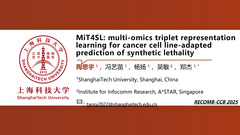[口头报告]MiT4SL: multi-omics triplet representation learning for cancer cell line-adapted prediction of synthetic lethality
MiT4SL: multi-omics triplet representation learning for cancer cell line-adapted prediction of synthetic lethality
编号:44
访问权限:仅限参会人
更新:2025-03-25 14:05:03
浏览:327次
口头报告

报告开始:2025年03月29日 14:10 (Asia/Shanghai)
报告时间:20min
所在会议:[S5] 一作面对面论坛(交叉) » [S5] 一作面对面论坛(交叉)
摘要
Synthetic lethality (SL) offers a promising approach for targeted cancer therapies. Current SL prediction models heavily rely on extensive labeled data for specific cell lines to accurately identify SL pairs. However, a major limitation is the scarcity of SL labels across most cell lines, which makes it challenging to predict SL pairs for target cell lines with limited or even no available labels in real-world scenarios. Furthermore, gene interactions could be opposite between training and test cell lines, i.e. SL vs. non-SL, which further aggravates the challenge of generalization among cell lines. A promising strategy is to transfer knowledge learned from cell lines with relatively abundant SL labels to those with limited SL labels for the discovery of novel SL pairs, i.e., cell line-adapted SL prediction. Here, we propose MiT4SL, a multi-omics triplet representation learning model for cell line-adapted SL prediction. The core idea of MiT4SL is to model cell lineage information as embeddings, which are generated by combining a protein-protein interaction network representation tailored to each cell line with the corresponding protein sequence embeddings. We then combine these cell line embeddings with gene pair representations derived from a biomedical knowledge graph and protein sequences. This triplet representation learning strategy enables MiT4SL to capture both shared biological mechanisms across cell lines and those unique to each cell line, effectively mitigating distribution shift and improving generalization to target cell lines. Additionally, explicit cell line embeddings provide the necessary signals for MiT4SL to effectively differentiate between cell line contexts, enabling it to adjust predictions and mitigate possible label conflict for the same gene pair across different cell lines. Experimental results across various cell line-adapted scenarios show that MiT4SL outperforms six state-of-the-art models. To the best of our knowledge, MiT4SL is the first deep learning model designed specifically for cancer cell line-adapted SL prediction.
关键字
报告人

发表评论